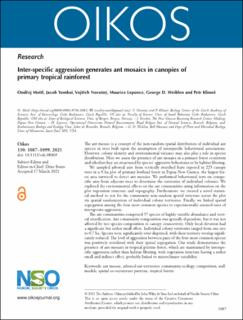| dc.contributor.author | Mottl, Ondrej | |
| dc.contributor.author | Yombai, Jacob | |
| dc.contributor.author | Novotný, Vojtěch | |
| dc.contributor.author | Leponce, Maurice | |
| dc.contributor.author | Weiblen, George D. | |
| dc.contributor.author | Klimeš, Petr | |
| dc.date.accessioned | 2022-04-05T09:28:41Z | |
| dc.date.available | 2022-04-05T09:28:41Z | |
| dc.date.created | 2021-08-11T12:46:05Z | |
| dc.date.issued | 2021 | |
| dc.identifier.issn | 0030-1299 | |
| dc.identifier.uri | https://hdl.handle.net/11250/2989870 | |
| dc.description.abstract | The ant mosaic is a concept of the non-random spatial distribution of individual ant species in trees built upon the assumption of interspecific behavioural associations. However, colony identity and environmental variance may also play a role in species distribution. Here we assess the presence of ant mosaics in a primary forest ecosystem and whether they are structured by species' aggressive behaviours or by habitat filtering.
We sampled arboreal ants from vertically stratified baits exposed in 225 canopy trees in a 9-ha plot of primary lowland forest in Papua New Guinea, the largest forest area surveyed to detect ant mosaics. We performed behavioural tests on conspecific ants from adjacent trees to determine the territories of individual colonies. We explored the environmental effects on the ant communities using information on the plot vegetation structure and topography. Furthermore, we created a novel statistical method to test for the community non-random spatial structure across the plot via spatial randomisation of individual colony territories. Finally, we linked spatial segregation among the four most common species to experimentally assessed rates of interspecies aggression.
The ant communities comprised 57 species of highly variable abundance and vertical stratification. Ant community composition was spatially dependent, but it was not affected by tree species composition or canopy connectivity. Only local elevation had a significant but rather small effect. Individual colony territories ranged from one tree to 0.7 ha. Species were significantly over-dispersed, with their territory overlap significantly reduced. The level of aggression between pairs of the four most common species was positively correlated with their spatial segregation. Our study demonstrates the presence of ant mosaics in tropical pristine forest, which are maintained by interspecific aggression rather than habitat filtering, with vegetation structure having a rather small and indirect effect, probably linked to microclimate variability. | en_US |
| dc.language.iso | eng | en_US |
| dc.publisher | Wiley | en_US |
| dc.rights | Navngivelse 4.0 Internasjonal | * |
| dc.rights.uri | http://creativecommons.org/licenses/by/4.0/deed.no | * |
| dc.title | Inter-specific aggression generates ant mosaics in canopies of primary tropical rainforest | en_US |
| dc.type | Journal article | en_US |
| dc.type | Peer reviewed | en_US |
| dc.description.version | publishedVersion | en_US |
| dc.rights.holder | Copyright 2021 The Author(s) | en_US |
| cristin.ispublished | true | |
| cristin.fulltext | original | |
| cristin.qualitycode | 2 | |
| dc.identifier.doi | 10.1111/oik.08069 | |
| dc.identifier.cristin | 1925305 | |
| dc.source.journal | Oikos | en_US |
| dc.source.pagenumber | 1087-1099 | en_US |
| dc.identifier.citation | Oikos. 2021, 130 (7), 1087-1099. | en_US |
| dc.source.volume | 130 | en_US |
| dc.source.issue | 7 | en_US |

